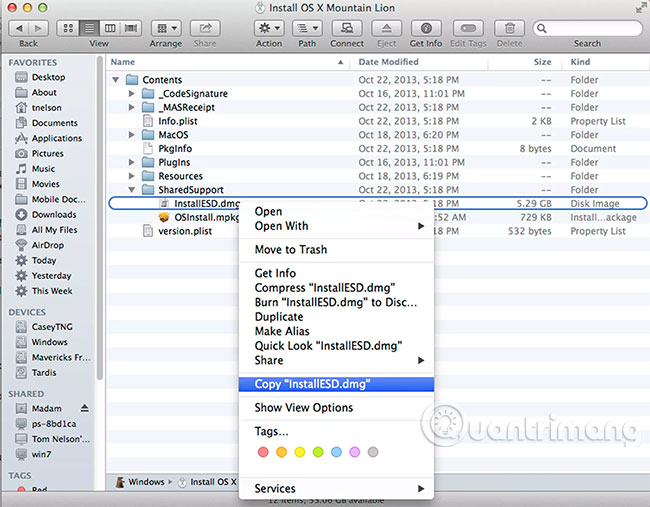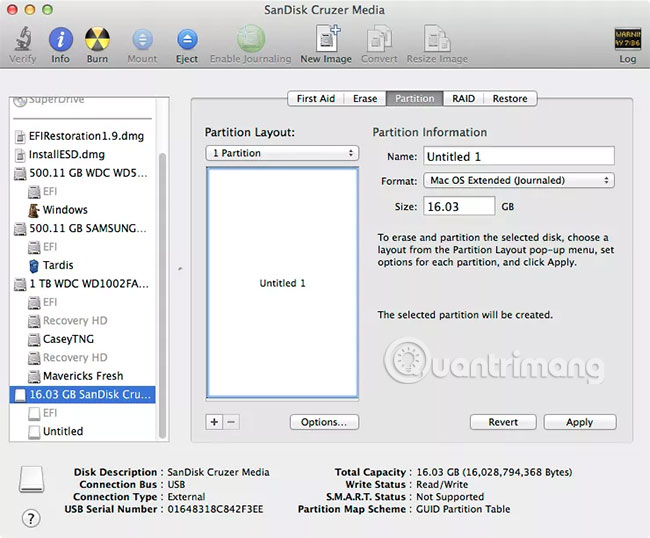Create a bootable copy of the OS X Mountain Lion installer
Because OS X Mountain Lion is downloadable software, it does not include a physical installer, typically a bootable DVD or USB drive. For most Mac users, installing Mac OS X on a removable media (DVD or flash drive) when installing cleanly on the boot drive is a must.
This tutorial guides you through the process of creating the OS X Mountain Lion installer on DVD or USB.
Although Apple ended support for OS X Mountain Lion in August 2016, it is still available for purchase at the Apple Store. Purchasing will generate the download code for you to import into the Mac App Store when downloading the software.
How to create OS X Mountain Lion installer on DVD or USB
- What you need
- Locate the installation of Mountain Lion image
- Burn the bootable DVD of the Lion X Mountain Lion installer
- Copy the installer Lion X Mountain Lion to the USB can boot
- Delete and format USB
- Copy the InstallESD.dmg file to the flash drive
What you need

You need a dual layer DVD (DVD with double sided recording) and a disc or USB drive. DVD dual layer has two layers, increasing the available recording space to about 8.5GB. The OS X Mountain Lion installer is just too big a thing to match the standard DVD. DVD dual layer is available wherever standard DVDs are sold. If your Mac doesn't have an integrated SuperDrive, use an external DVD burning tool.
You can also use a USB flash drive with at least 5GB capacity (8GB and 16GB are available sizes) as a bootable medium.
Download a copy of OS X Mountain Lion that you must purchase at Apple Store online and download it from the Mac App Store. It is saved in the Applications folder on the Mac. This file is called Install OS X Mountain Lion .
You must create a bootable copy of the installer before you install Mountain Lion, because the setup process will delete the files you need to create a bootable copy of the installer.
Locate the installation of Mountain Lion image

The installation of Mountain Lion that you need to create a bootable DVD or USB drive is contained in the Install OS X Mountain Lion file that you downloaded from the Mac App Store.
Because the image is contained in the downloaded file, copy it to the desktop to create an image that can be booted as easily as possible.
1. Open the Finder window and go to the Applications folder (/ Applications).
2. Scroll through the list of files and find the file called Install OS X Mountain Lion .
3. Right-click the Install OS X Mountain Lion file and select Show Package Contents from the pop-up menu.
4. Open the Contents folder and then open the SharedSupport folder . You will see a file called InstallESD.dmg.
5. Right-click the InstallESD.dmg file and select Copy InstallESD.dmg from the pop-up menu.
6. Close the Finder window and return to the desktop.
7. Right-click an empty area on the desktop and select Paste Item from the pop-up menu.
Pasting an item into the desktop takes some time, so be patient.
When the process is finished, you have a copy of the InstallESD.dmg file that you need to create a bootable copy on the desktop.
Burn the bootable DVD of the Lion X Mountain Lion installer

With the Mountain Lion InstallESD.dmg file copied to the desktop, you're ready to burn the installer bootable DVD.
1. Insert a blank DVD disc into the Mac's optical drive.
2. If a message asks you what to do with the blank DVD, click the Ignore button . If the Mac is set to automatically launch an application related to DVD, when you insert the DVD, exit the application.
3. Launch Disk Utility, located in / Applications / Utilities.
4. Click the Burn icon , located in the top right corner of the Disk Utility window.
5. Select the InstallESD.dmg file you copied to the desktop.
6. Click the Burn button .
7. Put a blank DVD in the Mac's optical drive and click the Burn button again to create a bootable DVD containing OS X Mountain Lion.
8. When the burn is complete, remove the DVD, add the label and store the DVD in a safe location.
Copy the installer Lion X Mountain Lion to the USB can boot

If you can't burn DVDs, you can use a bootable USB drive. Create a bootable copy of Mountain Lion on a hard drive. All you need is the InstallESD.dmg file that you copied to the desktop and flash drive.
Delete and format USB
1. Insert the USB into the USB port of the Mac.
2. Launch Disk Utility, located in / Applications / Utilities.
3. In the Disk Utility window open, scroll through the list of devices in the left panel and select your USB device. It can be listed with multiple volume names. Do not select the volume name. Instead, choose the top-level name, usually the device's name, such as 16GB SanDisk Ultra .
4. Click the Partition tab .
5. From the Partition Layout drop-down menu , select 1 Partition .
6. Click the Options button .
7. Make sure that the GUID Partition Table is selected from the list of available partition schemes. Click OK. All data on the USB will be deleted.
8. Click the Apply button .
9. Disk Utility requires you to confirm that you want to partition the USB device. Click the Partition button .
USB device deleted and partition. When that process is complete, the flash drive is ready for you to copy the InstallESD.dmg file.
Copy the InstallESD.dmg file to the flash drive
1. Make sure the USB device is selected in the device list in Disk Utility. Do not select the volume name but select the device name
2. Click the Restore tab .
3. Drag the InstallESD.dmg item from the device list into the Source field . It will be near the bottom of Disk Utility's device list. You may need to scroll down to find it.
4. Drag the volume name of the USB device from the device list to the Destination field .
5. Some versions of Disk Utility may include a box labeled Erase Destination. If you fall into this situation, make sure this box is selected.
6. Click Restore.
7. Disk Utility asks you to confirm that you want to perform a restore, delete all information on the destination drive. Click Erase.
8. If Disk Utility requires an admin password, provide the information and click OK.
Disk Utility copies InstallESD.dmg data to USB device. When the process is complete, you will have a bootable copy of the OS X Mountain Lion installer ready to use.
Hope you are succesful.
You should read it
- Create installation drive OS X 10.8 Mountain Lion
- How to Install OS X Mountain Lion
- Upgrade OS X Lion to the Mountain Lion
- Some Macs use OS X 10.7 not to 10.8
- The 'mountain lion' operating system for Mac computers sold in July
- How to Upgrade to Mountain Lion
- Tips for using the Notification Center on OS X Mountain Lion
- OS X Mountain Lion can be sold on July 25
- Featured features on OS X Mountain Lion
- Fix errors when downloading Mountain Lion
- OS X Mountain Lion has a Golden Master version
- 5 little-known features on OS X Mountain Lion
May be interested

How to fix a blinking question mark on a Mac on startup

Use Disk Utility to copy the drive on Mac

How to create Mac Recovery HD on any drive

Use volume HD Recovery to reinstall or troubleshoot OS X

Back up the boot drive using Disk Utility

How to use Disk Utility to repair the hard drive and decentralize the drive






 Create installation drive OS X 10.8 Mountain Lion
Create installation drive OS X 10.8 Mountain Lion How to Install OS X Mountain Lion
How to Install OS X Mountain Lion Upgrade OS X Lion to the Mountain Lion
Upgrade OS X Lion to the Mountain Lion Some Macs use OS X 10.7 not to 10.8
Some Macs use OS X 10.7 not to 10.8 The 'mountain lion' operating system for Mac computers sold in July
The 'mountain lion' operating system for Mac computers sold in July How to Upgrade to Mountain Lion
How to Upgrade to Mountain Lion